一、线性回归原理
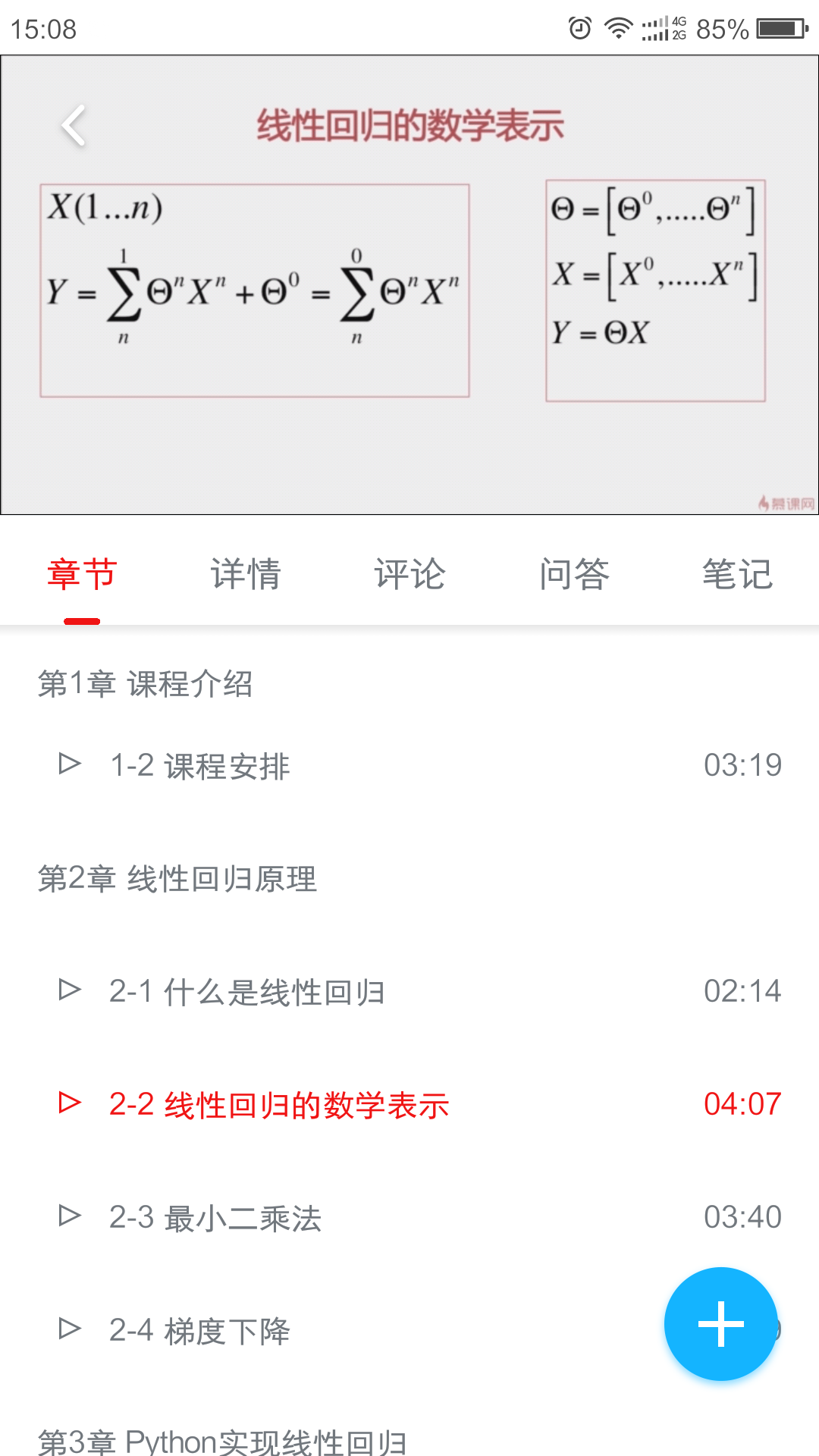
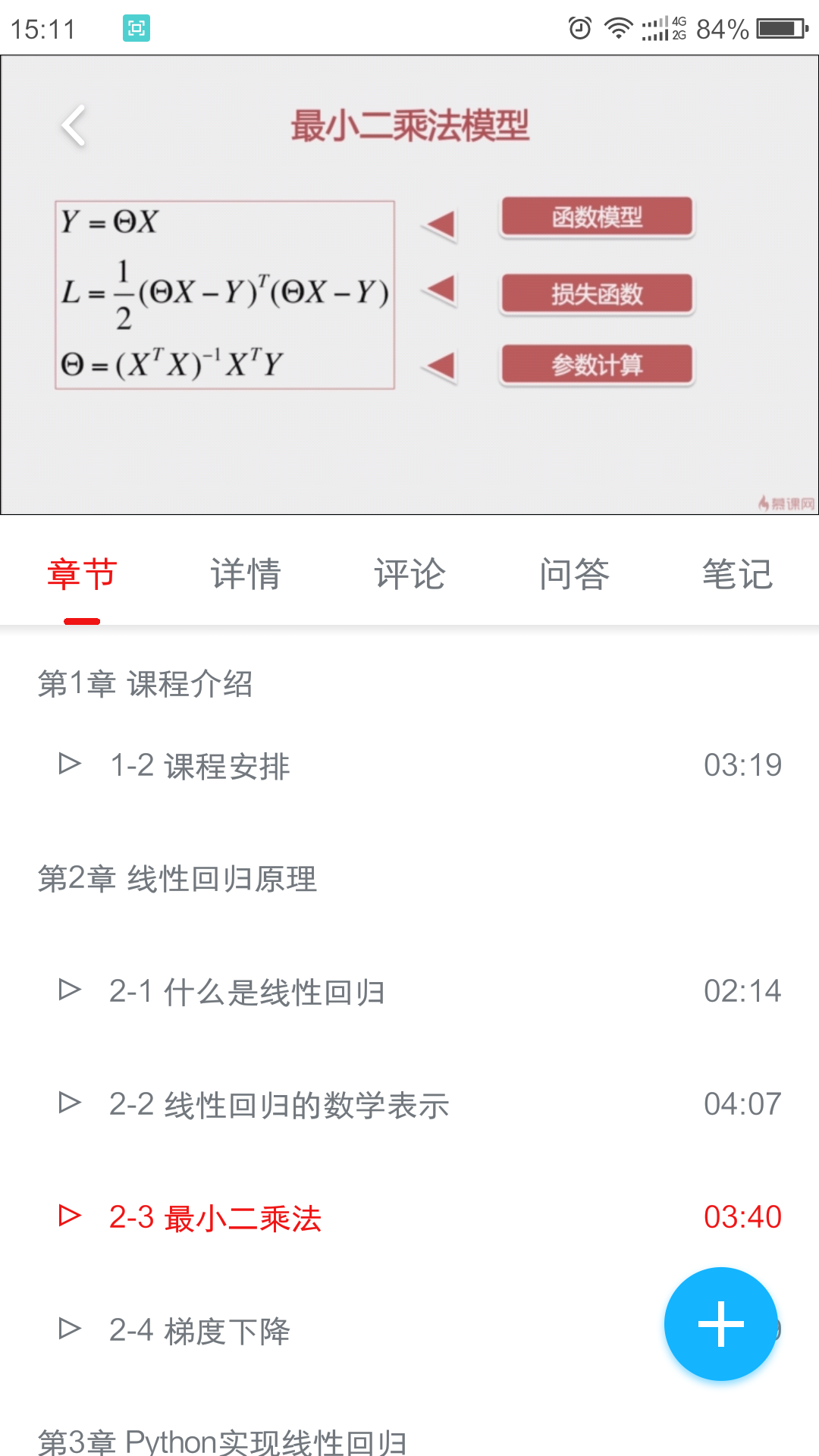
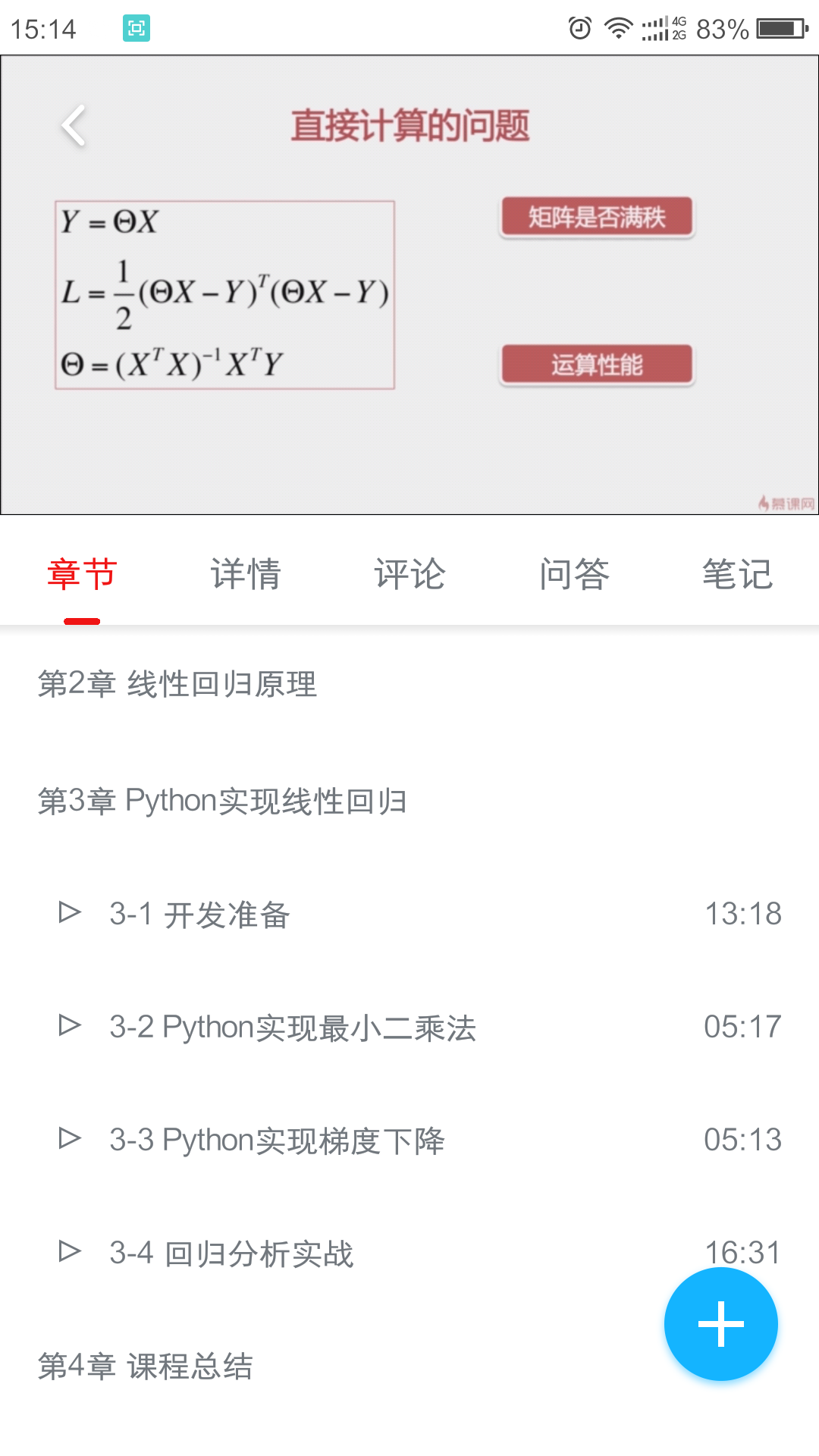
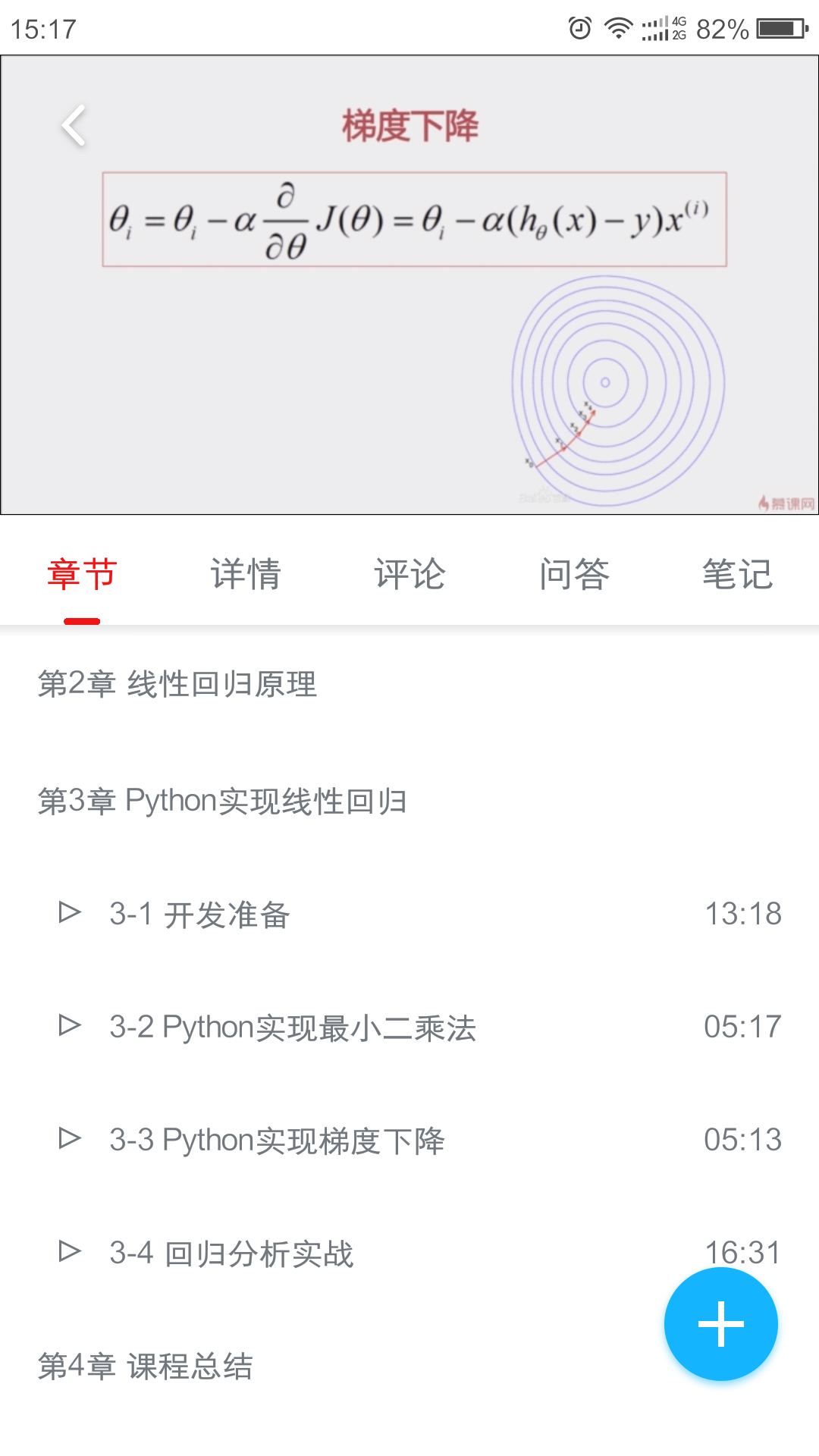
二、python实现线性回归
1.基本矩阵运算
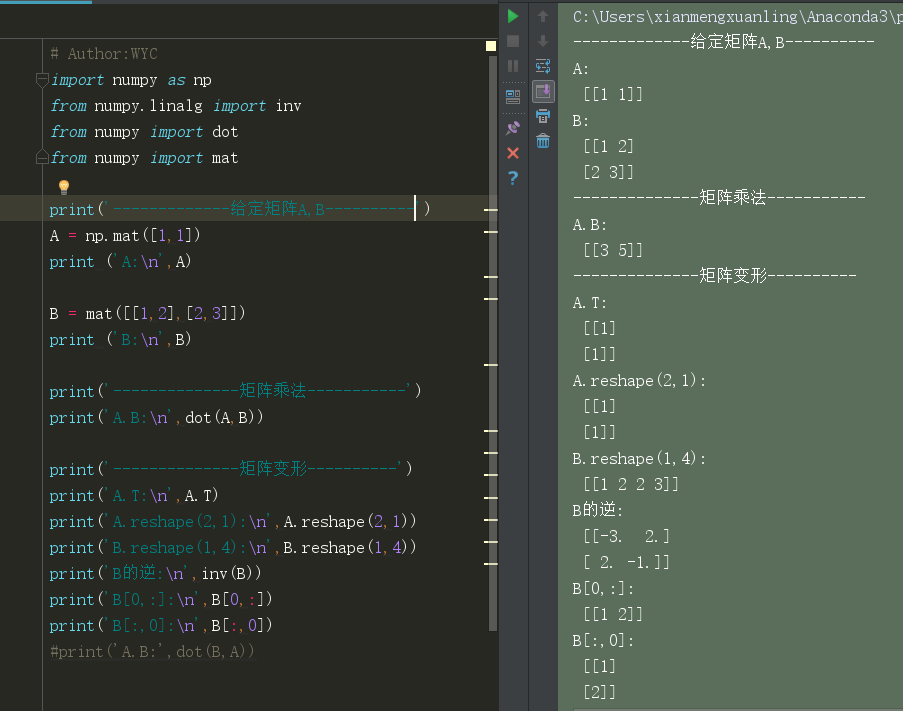
pratice1.py:
# Author:WYC
import numpy as np
from numpy.linalg import inv
from numpy import dot
from numpy import mat
print('-------------给定矩阵A,B----------')
A = np.mat([1,1])
print ('A:\n',A)
B = mat([[1,2],[2,3]])
print ('B:\n',B)
print('--------------矩阵乘法-----------')
print('A.B:\n',dot(A,B))
print('--------------矩阵变形----------')
print('A.T:\n',A.T)
print('A.reshape(2,1):\n',A.reshape(2,1))
print('B.reshape(1,4):\n',B.reshape(1,4))
print('B的逆:\n',inv(B))
print('B[0,:]:\n',B[0,:])
print('B[:,0]:\n',B[:,0])
#print('A.B:',dot(B,A))
2.实现最小二乘法
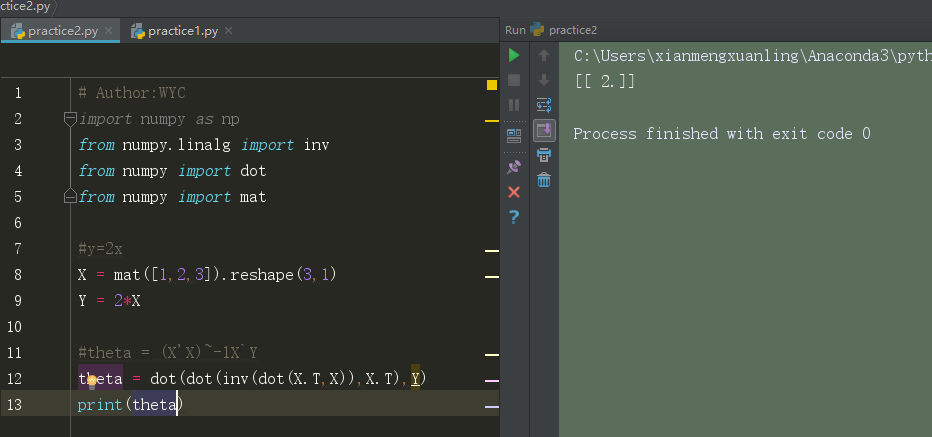
pratice2.py:
# Author:WYC
import numpy as np
from numpy.linalg import inv
from numpy import dot
from numpy import mat
#y=2x
X = mat([1,2,3]).reshape(3,1)
Y = 2*X
#theta = (X'X)~-1X`Y
theta = dot(dot(inv(dot(X.T,X)),X.T),Y)
print(theta)3.实现梯度下降法
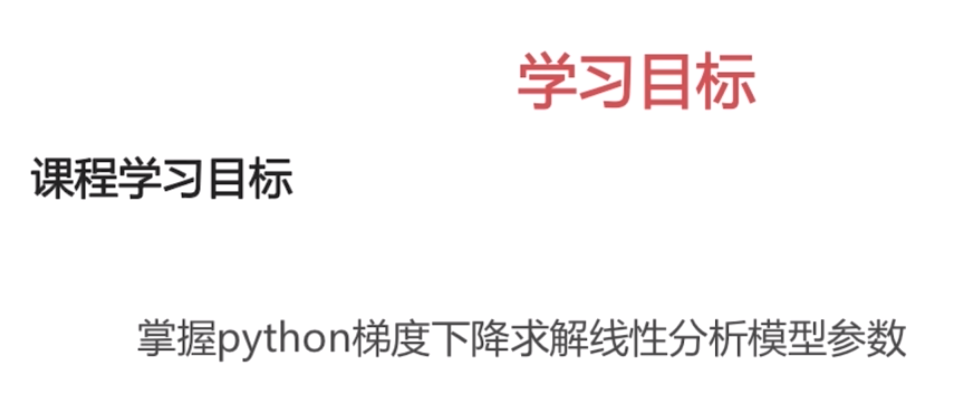
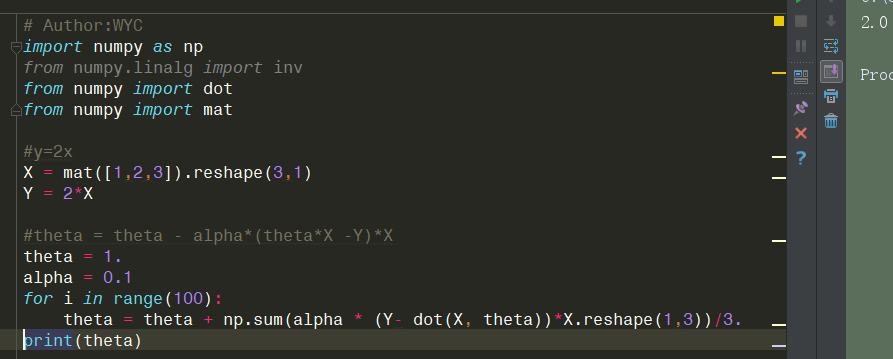
扫描二维码关注公众号,回复:
453149 查看本文章


pratice3.py:
# Author:WYC
import numpy as np
from numpy.linalg import inv
from numpy import dot
from numpy import mat
#y=2x
X = mat([1,2,3]).reshape(3,1)
Y = 2*X
#theta = theta - alpha*(theta*X -Y)*X
theta = 1.
alpha = 0.1
for i in range(100):
theta = theta + np.sum(alpha * (Y- dot(X, theta))*X.reshape(1,3))/3.
print(theta)4.回归分析实战

注:从笔记上copy一个网友的数据生成,列数不够,缺少y和x0部分,进行了修改,后面很多次试验用梯度下降方法求解thera都是NAN的结果,经过调试,发现可能是小数保留位数太多所致,所以用round函数保留一位小数,做到和讲解的数据一致:
data.py:
# Author:WYC
import random
def Y(X0, X1, X2, X3):
return 0.65 * X1 + 0.70 * X2 - 0.55 * X3 + 1.95
def Produce():
filename = 'data.csv'
with open(filename, 'w') as file:
file.write('X0,Y,X1,X2,X3,\n')
for i in range(200):
random.seed()
x0 = i
x1 = round(random.random() * 2,1)
x2 = round(random.random() * 2,1)
x3 = round(random.random() * 2,1)
y = round(Y(x0 , x1, x2, x3),1)
try:
file.write(str(x0) + ',' + str(y) +',' + str(x1) + ',' + str(x2) + ',' + str(x3) + '\n')
except e:
print ('Write Error')
print (str(e))
if __name__ == '__main__':
Produce()
#打印csv中的数据格式,后面几行可以不要
import pandas as pd
dataset = pd.read_csv('data.csv')
print(dataset)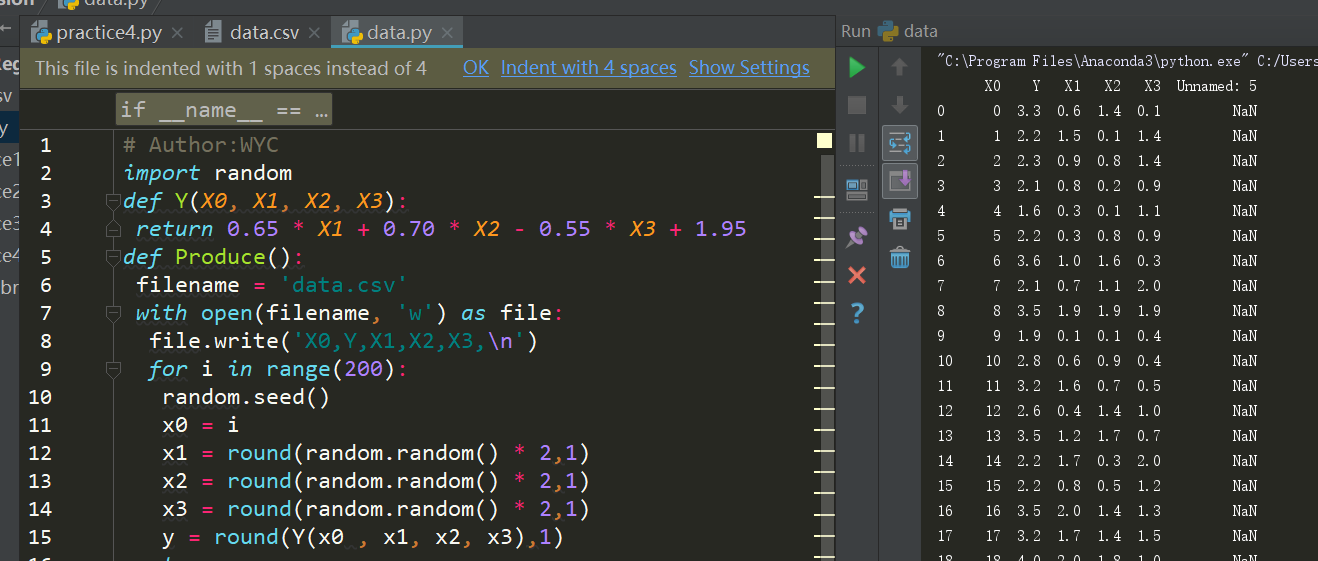
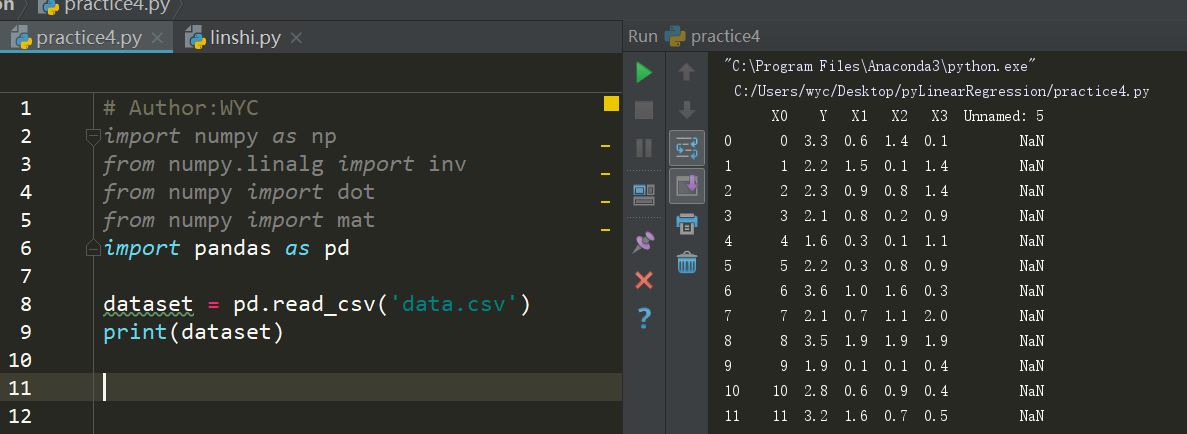
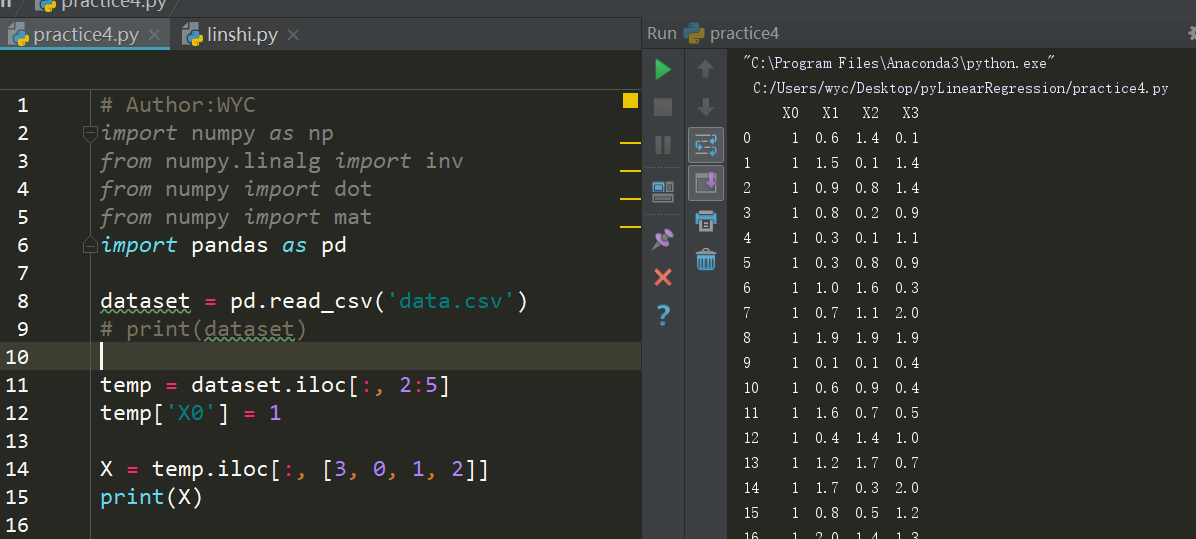
获得x
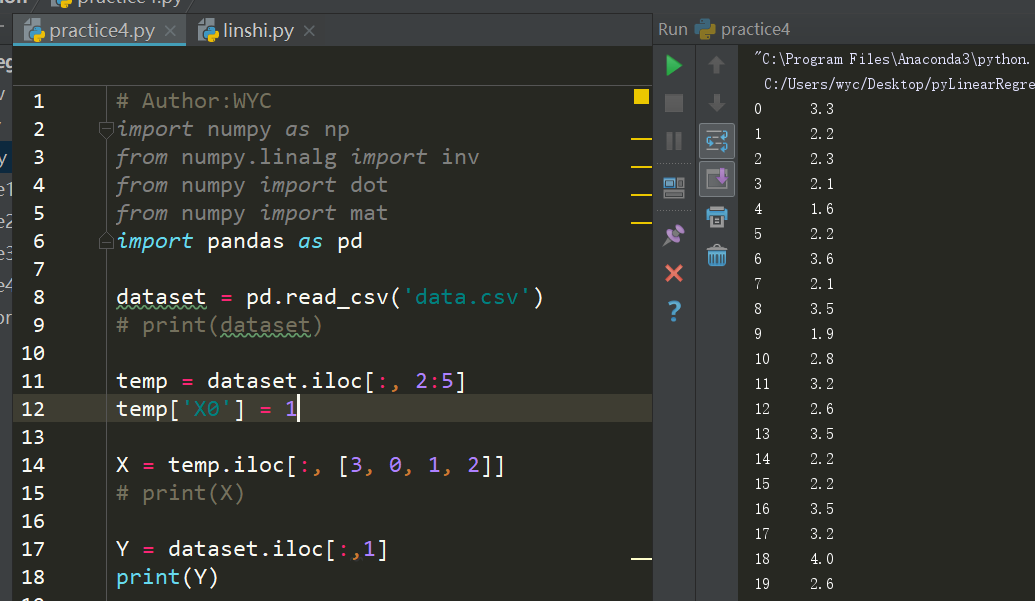
获得y
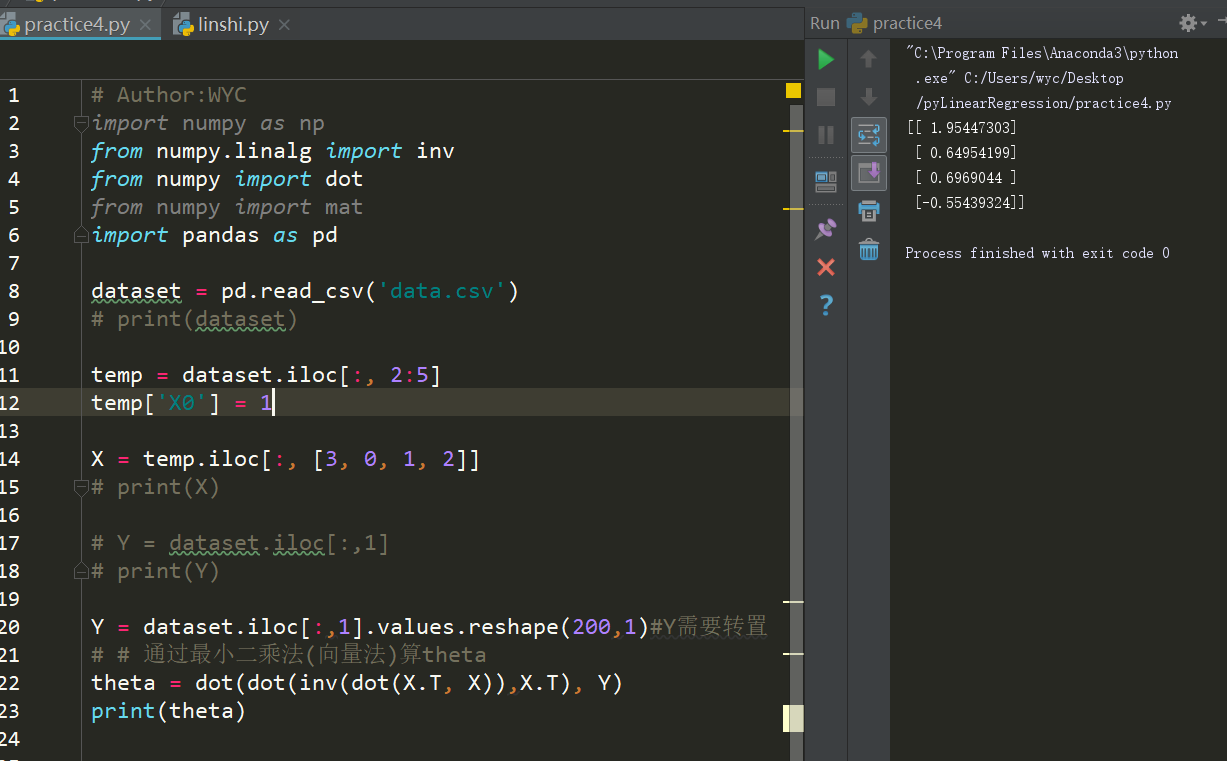
通过最小二乘法计算thera值
# Author:WYC
import numpy as np
from numpy.linalg import inv
from numpy import dot
from numpy import mat
import pandas as pd
dataset = pd.read_csv('data.csv')
# print(dataset)
temp = dataset.iloc[:, 2:5]
temp['X0'] = 1
X = temp.iloc[:, [3, 0, 1, 2]]
# print(X)
# Y = dataset.iloc[:,1]
# print(Y)
Y = dataset.iloc[:,1].values.reshape(200,1)#Y需要转置
# # 通过最小二乘法(向量法)算theta
theta = dot(dot(inv(dot(X.T, X)),X.T), Y)
print(theta)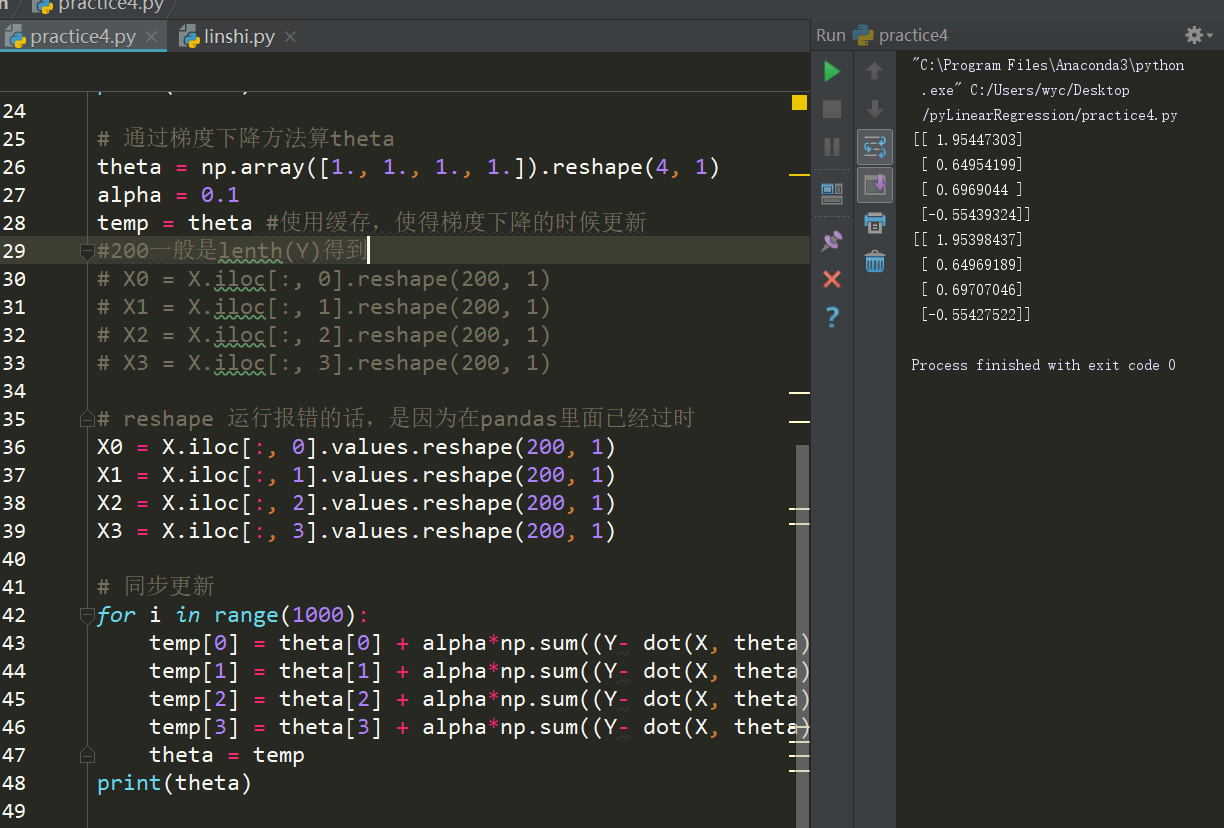
通过梯度下降法计算thera值
pratice4.py全部代码如下:
# Author:WYC
import numpy as np
from numpy.linalg import inv
from numpy import dot
from numpy import mat
import pandas as pd
dataset = pd.read_csv('data.csv')
# print(dataset)
temp = dataset.iloc[:, 2:5]
temp['X0'] = 1
X = temp.iloc[:, [3, 0, 1, 2]]
# print(X)
# Y = dataset.iloc[:,1]
# print(Y)
Y = dataset.iloc[:,1].values.reshape(200,1)#Y需要转置
# # 通过最小二乘法(向量法)算theta
theta = dot(dot(inv(dot(X.T, X)),X.T), Y)
print(theta)
# 通过梯度下降方法算theta
theta = np.array([1., 1., 1., 1.]).reshape(4, 1)
alpha = 0.1
temp = theta #使用缓存,使得梯度下降的时候更新
#200一般是lenth(Y)得到
# X0 = X.iloc[:, 0].reshape(200, 1)
# X1 = X.iloc[:, 1].reshape(200, 1)
# X2 = X.iloc[:, 2].reshape(200, 1)
# X3 = X.iloc[:, 3].reshape(200, 1)
# reshape 运行报错的话,是因为在pandas里面已经过时
X0 = X.iloc[:, 0].values.reshape(200, 1)
X1 = X.iloc[:, 1].values.reshape(200, 1)
X2 = X.iloc[:, 2].values.reshape(200, 1)
X3 = X.iloc[:, 3].values.reshape(200, 1)
# 同步更新
for i in range(1000):
temp[0] = theta[0] + alpha*np.sum((Y- dot(X, theta))*X0)/200.
temp[1] = theta[1] + alpha*np.sum((Y- dot(X, theta))*X1)/200.
temp[2] = theta[2] + alpha*np.sum((Y- dot(X, theta))*X2)/200.
temp[3] = theta[3] + alpha*np.sum((Y- dot(X, theta))*X3)/200.
theta = temp
print(theta)
(完结)